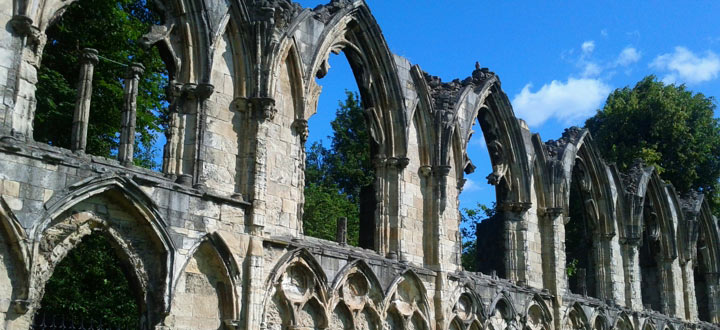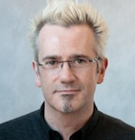Only the ruins of St Mary’s Abbey Church remain in York’s Museum Gardens. But the choral voices that once echoed around its majestic vaults are singing out once again, with the help of groundbreaking research by our electronics experts.
Students and staff in the department’s pioneering Audio Lab are working on an acoustic reconstruction or ‘auralisation’. This allows modern-day visitors to listen to the sound of footsteps and voices in what was one of York’s most important seats of religious power and influence.
Auralisation
“It’s about painting a complete picture. The past was not a silent place,” explains Dr Damian Murphy, researcher in audio and music technology who leads the project. “Auralisation is the audio equivalent of visualisation. It is an important part of telling the complete story of what a planned building might be like, or what it would have been like in the past.”
Drawing on existing archaeological and historical knowledge of St Mary’s, the researchers produced a digital 3-D model including interior columns, roofing structures and archways – all elements with the potential to affect the tone and quality of the sound as it spread down the nave, aisles and transepts.
https://soundcloud.com/university-of-york/recreating-the-sound-of-a-sixteenth-century-abbey-in-york
This four-part vocal piece was recorded in an acoustic-free anechoic chamber. After eight seconds, the singers are ‘placed’ in York Minster, based on impulse responses measured within the Minster. At 22 seconds, the acoustics of York Minster are slowly changed to St Mary’s Abbey, based on the computer model created by our research teams.
Acoustic fingerprint
“We used the visual information from the St Mary’s model to produce an acoustic fingerprint – this sets the parameters of what the building would sound like. We then superimposed recorded sound, in this case singing, onto the fingerprint through a process of digital simulation, or audio convolution, to give us the acoustic reconstruction,” said Dr Murphy.
Students are constantly refining the model with new measurements and minor adjustments, based on interpretations of the historical record and the stones that remain, helping to complete our acoustic understanding of the 500-year-old building which once rivalled York Minster in size and spectacle.
Heritage buildings are an important focus for Dr Murphy, but the techniques he uses to tell aural stories from the past are also applied to more contemporary issues.
He explains: “Noise in our environment is an increasing problem, rating alongside air pollution in terms of the effect it has on our day-to-day lives.”
Environmental noise
It is possible to put a figure on environmental noise levels, but this does not measure how a person experiences the noise.
“What’s more effective is to be able to recreate the sound of a planned new railway line or a new road and give people an idea of what it will sound like from their house or from their village. We can use auralisation to do this.”
Nationally, the technique is playing an increasing role in planning and design processes making sure the acoustic impact of planned new developments, such as the proposed HS2 railway, is considered alongside the visual impact.
The team is also refining ways to measure our reactions to noise. Some people are more tolerant of particular types of noise. “For instance, if you live in a village and your daily soundscape consists of birds singing or dogs barking in the distance, what we might consider natural sounds, then anything that changes that soundscape is going to have an impact on your life. You are probably not going to like it.”
The context of noise
The context of the noise is also important. Audio Lab researchers recently led a group of volunteers on a ‘sound walk’ through a city centre park in Leeds.
Dr Murphy explains: “One of the noisiest areas in the park in terms of measured sound was the skate park, but the participants said their experience of the skate park soundscape was one of happiness, associated with people having fun.
“In some other areas of the park, where measured sound levels were lower, the participants felt less happy, perhaps because these were more isolated areas, or had fewer people in them,” he said.
“It would be fine if all we had to do was produce an acoustic model or plot a graph to demonstrate sound levels, but at some point there is going to be a human being listening to what these abstract quantities actually represent. We all process our soundscape slightly differently and it’s important to take that into account.”
The Audio Lab researchers tackle this issue by organising listening panels, double blind tests and subjective measurements which are factored in to the results obtained from their acoustic modelling work.
“It is often the quality and the context of noise, rather than the quantity of it that puts people off their sleep and can make them feel stressed or ill.
“What we are doing is developing ways to allow people to experience soundscape and the noise that can, unfortunately, be part of our everyday lives, rather than look at figures on a graph. This gives a proper insight into what a new development will actually sound like. In many cases, that is just as important as what it will look like.”
The text of this article is licensed under a Creative Commons Licence. You're free to republish it, as long as you link back to this page and credit us.





